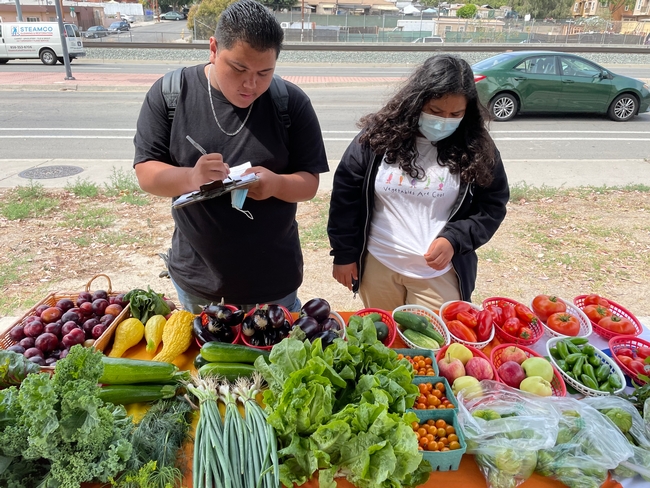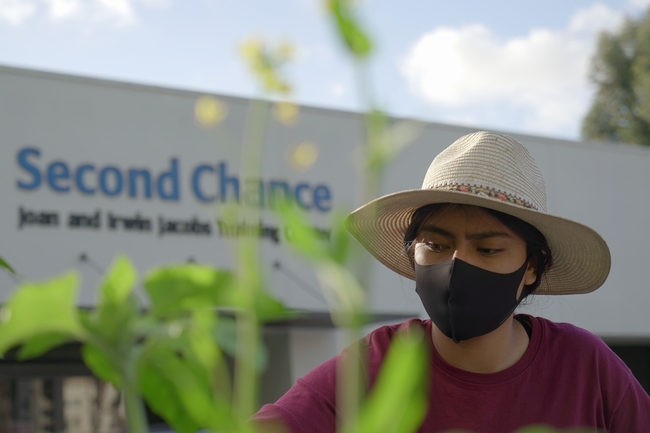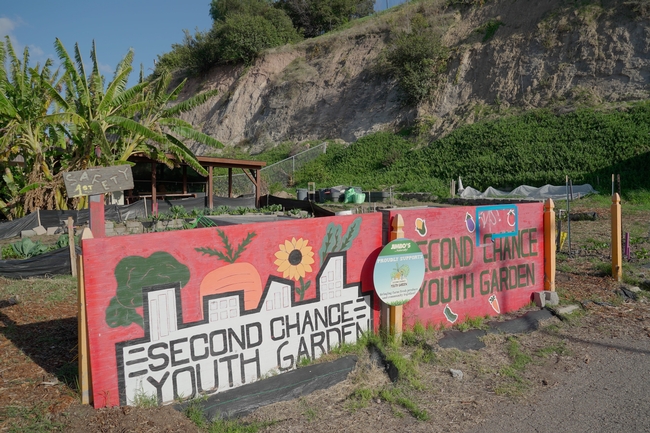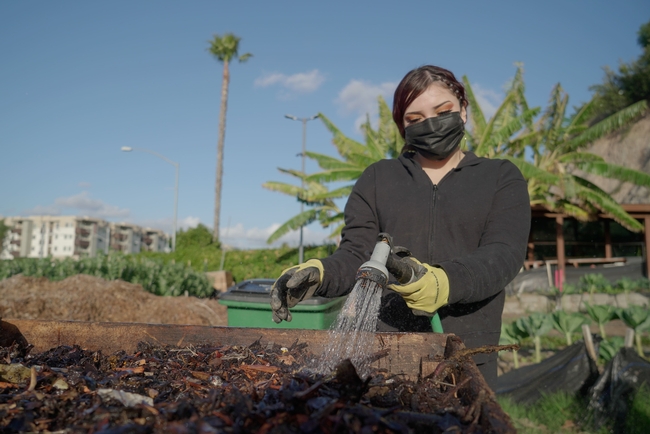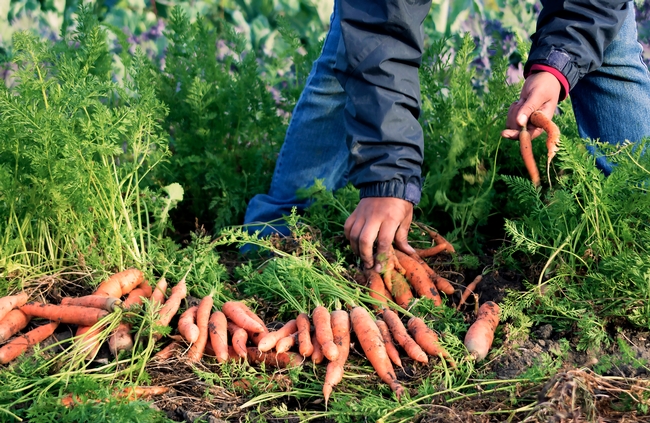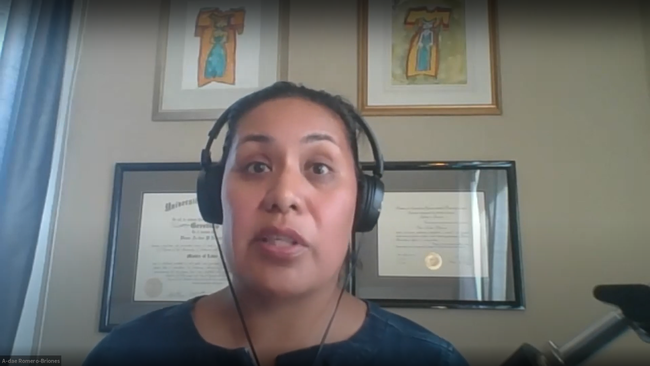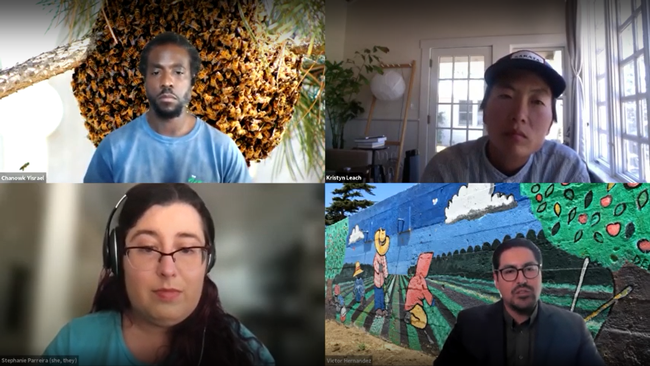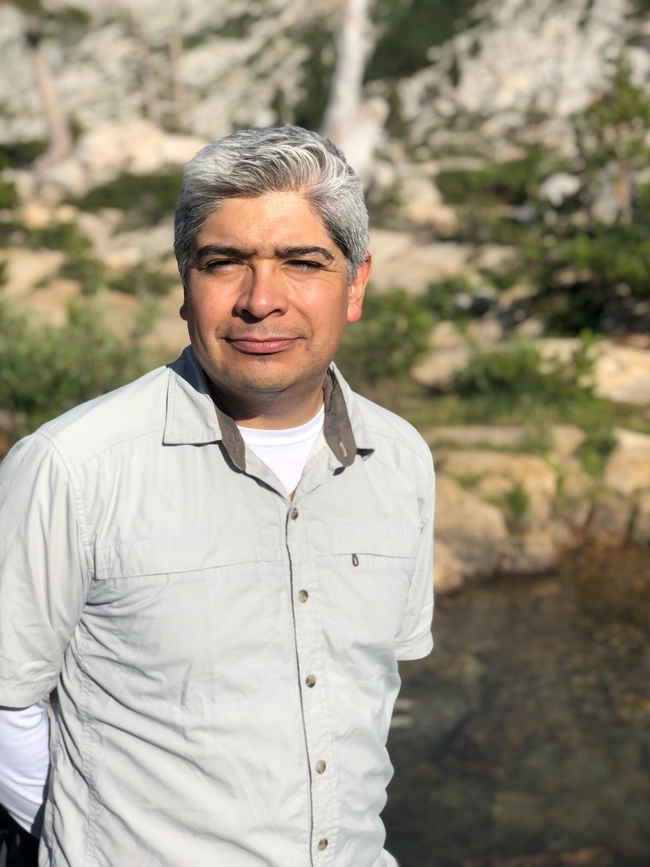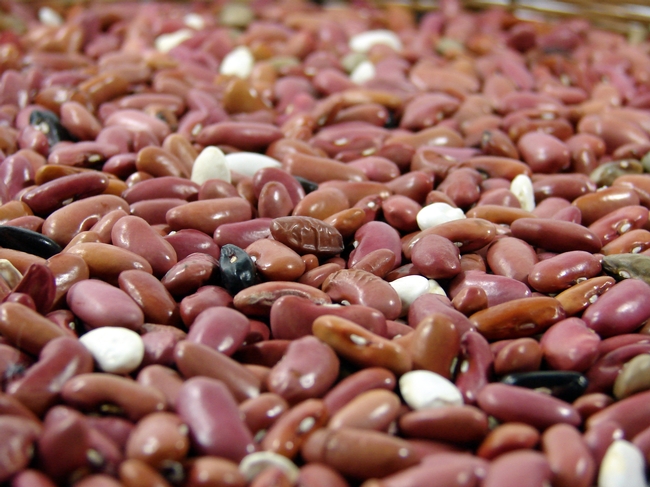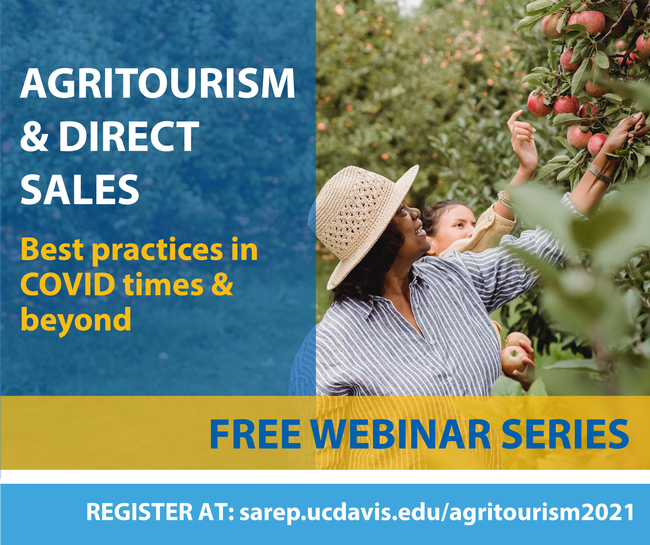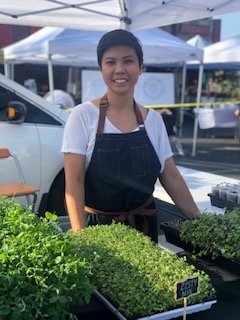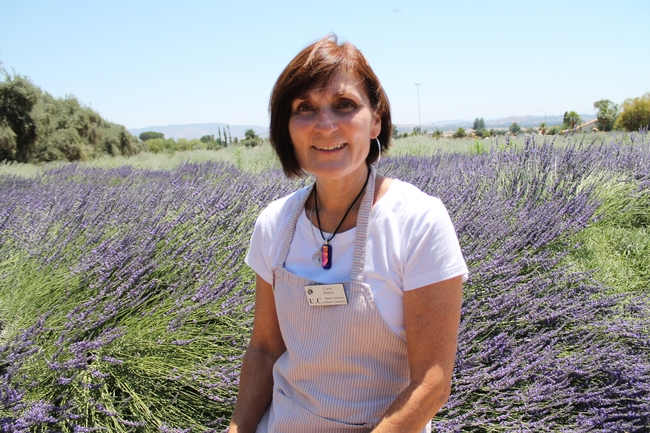Posts Tagged: SAREP
Youth-run garden provides 10,000 pounds of produce for San Diego families
UC SAREP's Sustainable Agriculture and Food Systems grant helps support Second Chance garden
Fifteen-year-old Xavier knows the anger within him will never leave. “I can't ever get rid of it,” he said.
“I've always wanted to just fight for no reason; I just had an anger issue, losing my temper quick with people,” added Xavier, a ninth-grader in San Diego County. “I have high expectations of myself.”
Xavier is working to keep his emotions under control, and he has found a sense of calm through his volunteer work. He was an intern – and then a peer supervisor – in the youth-run garden of Second Chance, a San Diego-based organization that works to break the cycles of poverty and incarceration by providing housing and job training to adults and young people.
Operating their garden as a small farm business, youth in the program, ages 14 to 21, offer produce to the community through their farm stand and a CSA (Community Supported Agriculture) model.
“The project incorporates a ‘farm to fork' approach in which youth not only experience how to grow food, but how to cook and eat healthfully,” said Gail Feenstra, director of the University of California Sustainable Agriculture Research and Education Program, which has a grant program that funds research and education projects – such as the youth garden – supporting sustainable food systems.
“Second Chance works primarily with youth in communities of color, providing them with training and also helping them develop confidence in themselves,” Feenstra said.
Filling a critical need for fresh produce
Caelli Wright, program manager of the Second Chance youth garden, said that grant funds from SAREP – a program of UC Agriculture and Natural Resources – have been used to purchase the supplies needed to sustain the program. The garden has filled a critical need for produce during the COVID-19 pandemic.
“After the pandemic hit, we recognized the increased need for fresh food in our neighborhoods,” Wright said. “That need was already there – southeast San Diego is considered a ‘food swamp' or ‘food apartheid', if you will – and with the onset of COVID, that need just escalated with unemployment and complications in our food production systems.”
Through a partnership with UC San Diego Center for Community Health and Encanto Elementary School (located down the block from the garden), donations enabled the program to give its CSA shares to about 25 families at Encanto. Over the course of the pandemic, the youth have grown 10,000 pounds of produce to donate.
At the same time, the program helps the young participants grow. For Xavier, being outdoors with peers empowered him to develop positive relationships. Previously, as a student in a charter school program, he was not accustomed to interacting with people and groups. Volunteering in the youth garden has given him a fresh perspective and understanding of others.
“Learning to be patient with people and [to] accept sometimes that if I don't know something, I need to ask about it, because I used to be so in my ego that I thought I knew everything,” Xavier explained. “But I don't know everything – I just learned to accept some things…that's just being part of life. And that's something that the garden has helped me with, personally.”
Opportunities for personal, social growth
Developing – and redeveloping – social skills are especially important for students, as they return from the disconnections associated with remote learning.
“Right now, with a lot of students facing the aftermath of COVID and being restricted to learning at home and not getting as much social interaction in their daily lives, it's led to a lot of challenges, mental health-wise, and social and emotional learning-wise,” Wright said. “The garden program provides that opportunity that some youth have been missing out on.”
In southeast San Diego, such crucial opportunities for personal growth and career exploration are harder to come by, and Second Chance started the garden in 2012 to give youth a unique work experience and valuable skills. About 400 young people have participated in the program.
“The youth that we serve are coming from low-income neighborhoods that are underserved with resources,” Wright said. “They just are not exposed to the same opportunities [as those in higher-income areas] to build skills or be ready for the workforce or to reach higher education – so that's where our program comes in and helps deliver those needed services.”
Xavier, who originally came to the garden because he heard that landscaping could be a lucrative career, recently finished his second stint as a peer supervisor in the youth garden. With his new skills, he and his cousin are looking to start a business of their own, cutting grass and doing yardwork in their community.
And, late last month, Xavier transferred to a more traditional high school environment.
“Being in a charter school after two, three years,” he said, “I've realized I miss being around more people.”
Farmers of color share their contributions, concerns in UC SAREP webinar series
When agricultural advisors came to the Cochiti Pueblo in New Mexico during the 1940s, they lined the irrigation ditches with concrete, in the name of boosting efficiency and productivity. But in single-mindedly focusing on water delivery, they neglected to consider how the previously inefficient seepage sustained nearby fruit trees.
Their actions, as well-intentioned as they might have been, disrupted the local ecosystem and killed the trees that had fed many generations, according to A-dae Romero-Briones, who identifies as Cochiti and as a member of the Kiowa Tribe.
“In my language, we call the extension agents ‘the people who kill the fruit trees,'” said Romero-Briones, director of the Food and Agriculture Program for the First Nations Development Institute, a nonprofit that serves Tribal communities across the mainland, Alaska and Hawaii.
The historically tense relationship between Indigenous peoples and government-affiliated programs is one of the many complex dynamics discussed in a six-part webinar series, “Racial Equity in Extension,” facilitated by UC Sustainable Agriculture Research and Education Program.
Making communities of color in the agricultural sector more visible is a priority for Victor Hernandez, a sociologist and outreach coordinator for the USDA's Natural Resources Conservation Service. Hernandez, who has organized “Growing Together” conferences for Latino and Black farmers, is trying to get more farmers of color to participate in the upcoming 2022 Agricultural Census.
“If we cannot quantify the demographic, we cannot justify the need,” emphasized Hernandez, explaining that his office uses the data to direct resources that advance equity in service, program delivery and distribution of funds.
A legacy of mistrust
At the same time, however, Hernandez also acknowledged the challenges in registering growers of color for the census, conducted by the USDA's National Agricultural Statistics Service. (According to Brodt, USDA's most recent agricultural census, dating to 2017, counts approximately 25,000 producers of color among 128,535 total producers in California.)
“Many of us that are considered socially disadvantaged or historically underserved…a lot of times our peoples come from [nations with] oppressive governments,” Hernandez said. “And so when you come to the United States and you begin to build your life here, to go and engage with the federal government is not the first knee-jerk reaction.”
On top of government mistrust and fears of deportation or detention, other immigrant groups have seen mainstream agriculture – borne by the “Green Revolution” wave across the globe – replace deep-rooted cultural practices, said Kristyn Leach of Namu Farm in Winters.
“It just makes these small farmers distrust our own knowledge, the knowledge that's existed for centuries – before the kind of current iteration of agriculture that we're situated within right now,” said Leach, who works to preserve the agricultural heritage of her Korean ancestors, and facilitates a farmers' collaborative called Second Generation that adapts Asian crop varieties to climate change.
According to Romero-Briones, a collective memory of supplanted culture also lingers in Indigenous communities. In the Cochiti Pueblo, “primarily a subsistence agriculture community” with a long history of corn cultivation, their practices are distinct from those in the mainstream – including regenerative and sustainable agriculture.
Building relationships takes commitment
Given that legacy of cultural displacement and appropriation, how do extension professionals and other agricultural advisors slowly rebuild trust with communities of color? For Romero-Briones, it begins with a genuine respect for Indigenous practices, and she urges interested people to contact their local tribal historic preservation officer to begin strengthening those connections and understanding – beyond a couple of phone calls.
“As someone who works with Indigenous people all day, even I need to recognize sometimes I have to meet with people up to 12 times before we actually start talking about the work that I initially wanted to talk to them about,” Romero-Briones said.
In a similar vein, Chanowk Yisrael, chief seed starter of Yisrael Family Farms, encouraged listeners to reach out to members of the California Farmer Justice Collaborative – an organization striving for a fair food system while challenging racism and centering farmers of color.
“To use a farm analogy: we've got this ground, which is the farmers of color who have been neglected for a long period of time,” said Yisrael, who has grown his farm in a historically Black neighborhood of Sacramento into a catalyst for social change. “It's not just going to be as simple as just throwing some seeds and things are going to come up; you're going to have to do more – that means you got to get out and do much more than you would do for any other community.”
Investing time in a community is one thing – and backing it up with tangible resources is another. Technical expertise is only the “tip of the iceberg,” Leach said, as historically marginalized groups are also seeking land access and tenure, more affordable cost of living, and access to capital.
“All of those things are actually much bigger burdens to bear for most communities of color than not having the knowledge of how to grow the crops that we want to grow, and not knowing how to be adaptive and nimble in the face of climate change," Leach explained, highlighting California FarmLink as an essential resource. (The “Understanding Disparities in Farmland Ownership” webinar includes a relevant discussion on this subject.)
Bringing diverse voices to the table
Another key is ensuring that farmers and farm workers of color are represented in management and decision-making processes. Samuel Sandoval, a professor in the UC Davis Department of Land, Air and Water Resources and UC Cooperative Extension specialist in water management, develops outreach programs in English and Spanish for everyone from farm workers to the “boss of the boss of the boss.”
“It has to be changed,” he said, “because at the end, the person who is going to operate the irrigation system and turn on or off the valves, the person who is looking if there's a leak or not – that's the person who's not being informed, or has not been informed on purpose.”
That exclusion of certain groups can lead to a loss of invaluable knowledge. Leach said there is a real danger in ignoring the wisdom of communities that have contributed so much to the foundation of food systems in California and around the globe.
“These really kind of amazing, sophisticated and elegant agroecological systems that we don't often legitimize through the scientific language and perspectives aren't seen as being really technically proficient – but, in many ways, they're more dynamic and more resilient than the things that we're perpetuating right now,” she said.
As a concrete example, Sandoval said that while extension advisors and specialists conduct studies to remedy a plant disease, farm workers might be developing – separately and in parallel – their own solutions by asking for advice from their social networks via WhatsApp, a phone application.
A reimagining of collaboration, Sandoval said, would include (and compensate) people working in the field for sharing their perspectives – bringing together academics and farmers, integrated pest management experts and pesticide applicators, irrigation specialists and those who do the irrigation.
A need to look within
Concerns about inclusion and validating alternate sources of knowledge apply also to the recruitment process in extension. Leach said that she has seen listings for advisor jobs that would require, at a minimum, a master's degree – which would automatically disqualify her, despite her extensive knowledge of Asian heirloom vegetables.
“When you look at a job description and you see ‘Asian crop specialist,' only required qualification is a master's degree, and then somewhere down the long list of sort of secondary desired, recommended things is some knowledge of Asian crops or communities…you know that just says a lot in terms of what has weight,” Leach explained.
Before organizations can authentically connect with communities of color, they should prioritize diversity in their own ranks, said Romero-Briones. First Nations Development Institute had to ensure that they had adequate representation across the many Tribes that they serve.
“Before we start looking out, we have to start looking in,” she explained, “and that means we have to hire Indigenous people who know these communities.”
For extension professionals and other members of the agricultural community in California, the UC SAREP webinar series has helped spark that introspection and a meaningful reevaluation of institutional processes and assumptions.
“These discussions have been tremendously illuminating and eye-opening,” Brodt said. “But hearing and learning is just the start – it's incumbent on us, as an organization and as individuals, to take action to ensure that farmers of color and their foodways are truly respected and valued.”
The “Racial Equity in Extension” series is made possible by professional development funds from Western Sustainable Agricultural Research and Education.
Building institutional markets for plant-based proteins
This spring, the University of California Sustainable Agriculture Research and Education Program (UC SAREP) is joining a nationwide effort led by the non-profit Health Care Without Harm to build new markets in the healthcare sector for locally produced plant proteins.
More than 39% of Americans are looking to incorporate more plant-based foods into their diets (1). High-protein legume crops, like peas and beans, help meet this consumer demand for more “plant-forward” diets while also benefiting the environment through their role in building healthy farm soils.
Connecting producers of plant-based proteins to nearby hospitals through farm-to-hospital programs can be a win-win for participants — producers benefit from a new market while hospitals advance their mission to promote and protect community health through better diet-based interventions (2).
The success of a farm-to-hospital program hinges on building successful collaborations and sometimes requires restructuring existing contracts or exploring new ones.
“Local food purchasing can be challenging with hospital food supply chains,” says Gail Feenstra of UC SAREP. “But the interest is there: sourcing local fresh foods and plant-based protein is good for diets and for regional prosperity. Hospitals and producers sometimes need someone to help bring them together to figure out how everyone can benefit. That's where this project comes in.”
The project team, which also includes the Community Alliance with Family Farmers, Colorado State University Extension and Ecotrust, will be organizing a series of events in the coming year connecting health care representatives with producers in their regions.
These “meet and greets” will give health care representatives an opportunity to share their needs for plant proteins and prepared products they'd like, and arrange special purchasing agreements with local producers.
Project participants will also receive support from Health Care Without Harm and be given access to a suite of Plant-Forward Future resources that will help them to be successful in implementing plant-forward menus.
UC SAREP is recruiting California-based producers, processors and value-added product manufacturers of plant proteins (especially dry pulses and fresh peas and beans) who are interested in learning more about selling to the health care sector.
As part of its mission of sustainability in regional food systems, UC ANR partners with communities to help ensure fresh, local food is finding its way to consumers through a growing number of channels, including farm-to-institution programs.
UC ANR offers free online trainings on direct sales and agritourism
The economic shocks brought on by the COVID-19 pandemic have pushed California's farmers and ranchers to quickly embrace new business practices — including creative new ways to sell directly to consumers. UC ANR and partners are offering an eight-part series of free virtual trainings to help producers build their businesses with agritourism and other direct-to-consumer sales.
The COVID-19 pandemic has been a huge shock to California's food economy, forcing many of the state's growers to embrace new business practices and drop old ones as “shelter-in-place” directives rolled across the state.
But the pandemic's challenges bring new opportunities too. Consumers' interest in local food and local outdoor experiences has grown immensely, from community-supported agriculture (CSA) and other online ordering, delivery and on-farm pickup options, to visits to farm stands, U-pick operations and other family-friendly socially distanced outdoor activities.
Pivoting to these new marketing channels opens new revenue opportunities for farmers and ranchers across California and the nation. But each new marketing channel also demands new skills and connections.
To help build growers' skills to embrace these market channels, the University of California Sustainable Agriculture Research and Education Program (UC SAREP) at UC Agriculture and Natural Resources is partnering with the Community Alliance of Family Farmers (CAFF) and expert growers across California to offer the free webinar series Agritourism and Direct Sales: Best practices in COVID times and beyond.
Through eight one-hour virtual trainings held this spring, participants will learn about best practices for implementing a variety of direct-to-consumer sales approaches. These trainings are offered to anyone interested in learning more about direct-to-consumer sales and agritourism. Topics and dates are:
| Getting started with community supported agriculture |
Tuesday February 23, 11am–12pm PST |
| Best practices for U-pick operations | Monday March 8, 3-4pm PST |
| Operating a safe, healthy and successful farm stand | Monday March 22, 3-4pm PST |
| Best practices for visitor interaction with animals | Monday April 5, 3-4pm PST |
| Best practices for farm tours, workshops and farm-based education | Monday April 19, 3-4pm PST |
| Online sales options and methods | Monday May 3, 3-4pm PST |
| Creative marketing and staying connected with social media | Monday May 17, 3-4pm PST |
| Community collaboration – farm trails, tourism partners and more | Monday May 24, 3-4pm PST |
Register at sarep.ucdavis.edu/agritourism2021.
For more information:
Penny Leff, UC SAREP, paleff@ucanr.edu, 530.902.9763 (cell)
Funding for this webinar series was made possible by the U.S. Department of Agriculture's (USDA) Agricultural Marketing Service through grant #AM200100XXXXG177. Its contents are solely the responsibility of the authors and do not necessarily represent the official views of the USDA.
Small-scale growers meet virtually to discuss organic agriculture
Over 150 current and prospective organic growers gleaned practical information shared by UC Agriculture and Natural Resources experts at the “Introduction to Small-Scale Organic Agriculture” workshop held virtually on Dec. 15, 2020. While most attendees were from inland San Bernardino, Riverside, Los Angeles and Orange counties, a handful were
from other continents, including growers from Bangladesh and Sri Lanka who stayed connected into the wee hours of their morning.“I attended this workshop and it was very helpful to hear different aspects of organic farming from experienced people,” one attendee from Sri Lanka said in an email.
UC Sustainable Agriculture Research and Education Program (SAREP) Director Gail Feenstra and Deputy Director Sonja Brodt kicked off the day with a presentation on program goals and resources. SAREP supports the goals of growers by developing more sustainable agricultural practices and effective regional food systems. They described a new online self-directed training program for organic specialty crop farmers in California and those in transition at https://ofrf.org/beginning-farmer-training-program. They also discussed marketing and business management.
Houston Wilson, director of UC ANR's new Organic Agriculture Institute, provided an overview of the program and pointed out that organic farming is expanding throughout California and includes more than 360 commodities. UC ANR will continue to take a lead role in developing and extending research and extension to this important sector, he said.
UC Cooperative Extension sustainable food systems advisor Rachel Surls discussed legal basics such as permits, licenses and regulations. UC Cooperative Extension organic agriculture specialist Joji Muramoto talked about the importance of soil health, a very popular and important topic. Other UC Cooperative Extension presenters covered nitrogen management (small farms advisor Margaret Lloyd), irrigation management (irrigation specialist Amir Haghverdi), integrated pest management (IPM advisor Cheryl Wilen), and plant diseases (plant pathology specialist Alex Putman).
“Thank you for the great workshop and resource links you provided for workshop materials and beyond! I have already downloaded and started to incorporate information from a few of the UC ANR pest management guidelines and legal and marketing links,” wrote an attendee from Chino. “Tips from peers are always great, too.”
During the afternoon portion of the workshop, five California organic farmers shared tips from their experiences. Carol Hamre (123 Farm, Cherry Valley) spoke about her trials and successes regarding vertebrate pest control and drip irrigation. Grace Legaspi (Tiny Leaf Micro Farm, Temescal Valley) talked about the art and science of growing microgreens. Lisa Wright (RD Flavorfull Farm, Riverside) discussed the importance of planting the right varieties in the right seasons. Arthur Levine (Huerta del Valle, Ontario) stressed the importance of collaboration and working synergistically as a team, and the importance of inclusiveness in all practices. Richard Zapien (‘R Farm, UC Riverside) shared inspiring stories and opportunities regarding the popular and successful UC Riverside community garden he manages.
“I am very glad to attend this workshop as a Bangladeshi,” wrote a grateful attendee from half way around the world. “Really, I have learned many things about organic farming in this workshop. I am working in the Tree nuts sector in Bangladesh but I have only cashew nuts plantation and processing factory…. I want to make an organic farm on 25 acres of land to cultivate vegetables, fruits, livestock, and fishing. Thanks again.”
Following the workshop, an extensive list of UCANR and external resources on topics covered during the workshop was provided to attendees https://ucanr.edu/sites/smallscalefarming/RESOURCES_/.
“I wanted to thank you for such a great webinar,” replied another Southern California participant. “I am a farm business advisor with the non-profit Kitchen Table Advisors and I learned a lot myself. Thank you for providing this list of resources. I look forward to the webinar recordings and slides, which I hope to be able to share with some of my farmer clients.”
The efforts of our co-sponsors also led to the overall success of the workshop. Inland Empire Resource Conservation District (IERCD) Manager Mandy Parkes, co-moderator, discussed district irrigation and soil testing resources and handed out gift certificates throughout the day. Evelyn Hurtado from IERCD volunteered to translate the workshop recordings into Spanish and Maggie O'Neill shared membership information and resources from the San Bernardino County Farm Bureau. Other co-sponsors included the Riverside County and Orange County Farm Bureaus. The California Certified Organic Foundation promoted the workshop and heightened awareness of UC ANR's programs and activities in the field of organic agriculture.
The PowerPoint presentations and recordings in English will be posted on the UCCE San Bernardino County website: https://ucanr.edu/sites/smallscalefarming/ by Feb. 15, 2021, and the Spanish translations later this winter. Next year, if conditions allow, actual farm visits will be included.

